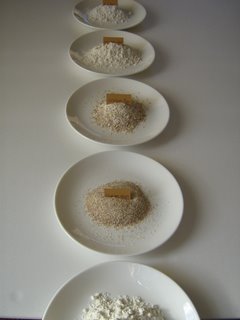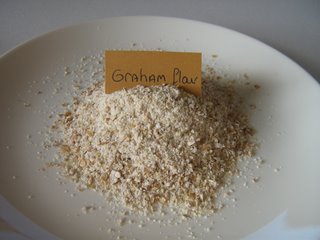 The things you do for blogging! Line up saucers with various kinds of flour just to show the difference...ah well. Nuts but harmless. Yep that's me! Here we go:
The things you do for blogging! Line up saucers with various kinds of flour just to show the difference...ah well. Nuts but harmless. Yep that's me! Here we go:
 There seems to be something called Graham flour. It's mentioned in quite a few bread baking books I own, and is not to be found anywhere in Holland. At this point any slightly (hah) addicted baker thinks something along the following lines: Must.Have.Graham.Flour.
There seems to be something called Graham flour. It's mentioned in quite a few bread baking books I own, and is not to be found anywhere in Holland. At this point any slightly (hah) addicted baker thinks something along the following lines: Must.Have.Graham.Flour.Can you imagine my delight when I saw a small box of Graham Something while on vacation in Sweden? I grabbed the box (small voice in the back of my head: it's rather small, is this what they are talking about?) Turns out it wasn't. To this day I still don't know what Graham Gryn is....I think it is a kind of oatmeal groats thing. (On the back of the package there are instructions for baking cookies and making porridge, haven't tried the porridge (brrr) nor the cookies yet. I did use it soaked in hot water as an addition to a whole wheat bread.)
 However, the next visit to a Swedish supermarket revealed 2 kg bags of Graham flour! Yippee! Bought that as well. Mystery solved. Was it? I still don't know. Upon reading the above Sweden vacation post Tanna expressed her surprise: "No whole wheat flour in Holland, that I would never have thought." Whole wheat = Graham flour? And the other day I read Ivonnes post on her bread baking class and Clivia, one of her readers, commented that in Sweden wholewheat flour is called graham flour. Graham flour = whole wheat flour?
However, the next visit to a Swedish supermarket revealed 2 kg bags of Graham flour! Yippee! Bought that as well. Mystery solved. Was it? I still don't know. Upon reading the above Sweden vacation post Tanna expressed her surprise: "No whole wheat flour in Holland, that I would never have thought." Whole wheat = Graham flour? And the other day I read Ivonnes post on her bread baking class and Clivia, one of her readers, commented that in Sweden wholewheat flour is called graham flour. Graham flour = whole wheat flour?Beth Hensperger writes the following in one of her books:
"While Graham flour is technically a whole wheat flour, it gives a very different flavor to bread -extra grain-sweet and nutty- because it is produced through a different milling process."For now I settle on the explanation found here which explains why it can be substituted with whole wheat flour and with the addition of coarsely ground wheat germ and wheat bran gives a similar texture to your bread. So, mystery solved at last.


And then another mystery guest. Pumpernickel! The confusion of pumpernickel as a name for a specific kind of bread and as a name for a specific kind of flour or flour mix. Again Wikipedia comes to the rescue: the explanation is very clear on the subject. The picture shown is of the bread we in Holland refer to as "Frisian roggebrood" a very dark, very dense type of bread, traditionally eaten with a generous layer of butter and sugar or cheese or as a side with our Erwtensoep, with "katenspek". This is not exactly a type of bread you can easily recreate at home, due to slow cooking times and low oven temperatures.
I think the confusion exists here in Holland too; we speak of Rye bread meaning bread made with rye flour/meal and Rye bread meaning the above mentioned dark slices... Beth says the following:
"Pumpernickel flour, also known as rye meal, is the coarsest grind, (-of rye flour-) with the most bran and germ left in."
 Let's just bake bread shall we?
Let's just bake bread shall we?

O dear Karen, i'm preparing a post too with some bowls of flour..hahaha..are we telepathic or what!
ReplyDeleteI, also an I-must-have-Graham-Flour-girl, was curious enough to import a few lb of graham flour from our King Arthur,all the way form the US. It says 'graham flour -whole wheat pastry flour' on the package. It looks like very fine milled whole wheat flour, not white-looking like Whiki says, but we overhere would probably call it 'fijn volkoren'. All the fuss over it has probably made it more special than it really is. I'm planning on baking with it soon..result will be on my blog.
The swedish examples on your photo's doesn't look anything like
it. I'm curious what you will make with those!!
This is most interesting, Baking Soda! You should have your own food show!
ReplyDeleteOf course I agree with Ivonne. But Herbert would say you are making an opera out of bread beaking ;)
ReplyDeleteIsnt't the main thing that we are having fun ?
Do have fun,
hugs angelika
I've always enjoyed the operatic approach myself.
ReplyDeleteThe international element adds a degree of complexity to the already foggy flour/grain identification dilemma. I had a similar whirlwind of alternate explanations when I tried to sort out the semolina-durum-golden durum dilemma.
There is an English flour/grain mixy thing used to make "granary" bread and rolls there. I'm not sure at all what's in it, and we haven't got it here in the US. for awhile. I really like the taste and texture. King Arthur offered something by that name, but it disappeared from their catalogue before I got around to it. Do you know what it is?
A fantastic loaf-beautiful crust!
ReplyDeleteHi Lindy,
ReplyDeleteI've heard of the granary bread and have seen some recipes making use of granary...but I don't know what's in it either. I don't think it's sold here.
Those differences in flour can make your head go foggy! And all those different names don't make it any easier. On my last trip to the mill I bought some "zeeuwse" flour made from wheat that is somewhat similar to semolina... I will try this for pasta and some cookies and let you know...
Oh Angelika, I do make an opera out of breadbaking I know! Even at the mill where I buy all my flour they are looking at me like I'm eh funny?
ReplyDeleteHi Jann,
Nice to meet you, welcome to my blog!
I know this post is a few years old, but I was looking for graham flour recipes and found an interesting article on the subject. I will send the link. Good luck in your baking endeavors. By the way, I love to bake as well. http://homecooking.about.com/cs/specificfood/a/graham.htm
ReplyDelete